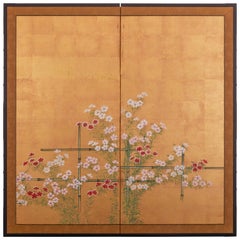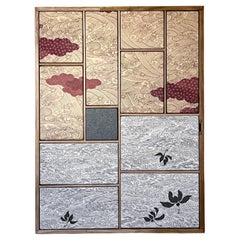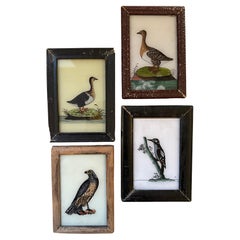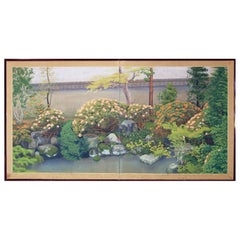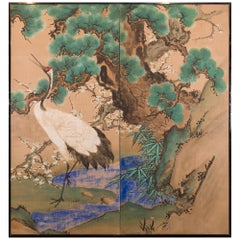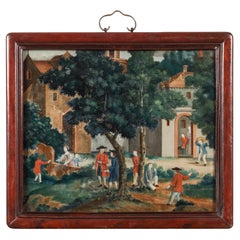Painted Paintings and Screens
to
108
342
142
673
52
6
20
9
8
6
5
4
2
1
1
1
1
1
1
75
316
282
58
102
65
36
12
1
14
2
4
10
9
7
7
2
326
277
261
169
164
639
532
331
178
59
731
698
709
17
2
2
2
1
Technique: Painted
Japanese Two Panel Screen: Nadeshiko on Bamboo Trellis
Located in Hudson, NY
Nadeshiko, also known as fringed pinks is a flowering plant native to Japan. Ink, mineral pigments and 18th century gold leaf, with good veining, on mulbe...
Category
18th Century Japanese Antique Painted Paintings and Screens
Materials
Gold, Bronze, Gold Leaf
Antique kimono textile art " Waves and clouds ~Eternity~ " by ikasu Beige, Japan
By Kimono ikasu
Located in Setagaya City, JP
This work is inspired by traditional hand-dying technique edo-komon, and is framed in paulownia wood originally used for a kimono chest-of-drawers.
It is elegantly framed with paulo...
Category
1920s Japanese Japonisme Vintage Painted Paintings and Screens
Materials
Silk, Wood
19th-Century Avian Masterpieces: Collection of Bird Paintings
Located in Southall, GB
This remarkable collection of 19th-century bird paintings beautifully captures the essence and elegance of various avian species. Each piece is a testament to the artist's keen obser...
Category
19th Century English Antique Painted Paintings and Screens
Materials
Glass
20th Century Showa Period Beautiful Spring Garden Folding Screen Two Panels
Located in Brescia, IT
Japanese screen with two doors painted with mineral pigments on rice paper. Early Showa period.
Category
Late 20th Century Japanese Showa Painted Paintings and Screens
Materials
Paper
Japanese Two Panel Screen Manchurian Crane and Turtles
Located in Hudson, NY
In Japan, cranes symbolize fidelity as they mate for life and turtles symbolize longevity. Additionally, this screen also has the Japanese motif of sho-chiku-bai, or the three friends of winter (pine, plum, and bamboo). So called the three friends of winter because all three flourish during the cold months. This screen was originally fusuma doors...
Category
Mid-19th Century Japanese Edo Antique Painted Paintings and Screens
Materials
Paper
A Chinese export reverse-glass painting after an English print in original frame
Located in Amsterdam, NL
Canton, late 18th century
In original hardwood frame with ruyi-shaped metal mount for suspension.
H. 38.7 x W. 44.3 cm (incl. frame)
H. 31.8 x W. 37.5 cm (image)
Chinese reverse glass paintings for export are known since mid 18th century. By the 1780's the copying of European, mainly English, engravings came into vogue in Chinese paintings on glass...
Category
Late 18th Century Chinese Chinese Export Antique Painted Paintings and Screens
Materials
Glass, Hardwood
Japanese Contemporary Gold Leaf Brown Framed Porcelain Panel by Master Artist, 3
Located in Takarazuka, JP
Exquisite museum quality Japanese contemporary framed porcelain panel art work consisting of three pieces intricately hand-painted showcasing a wintry ...
Category
21st Century and Contemporary Japanese Meiji Painted Paintings and Screens
Materials
Gold Leaf
Japanese Asian Signed Four-Panel Folding Byobu Showa Screen Lady Murasaki Genji
Located in Studio City, CA
A gorgeous and quite striking four-panel Japanese Byobu folding screen featuring an elegantly clad Lady Murasaki, the Japanese novelist, (and famed author of the classic "Tale of Gen...
Category
Mid-20th Century Japanese Showa Painted Paintings and Screens
Materials
Gold Leaf
Mughal miniature of Shah Jahan and Mumtaz Mahal, Late 19th Century
Located in Islamabad, PK
The Mughal miniature painting, created with a single-hair brush on delicate rice paper, is a fine example of the extraordinary skill and precision characteristic of Mughal art. This ...
Category
Late 19th Century Indian Anglo-Indian Antique Painted Paintings and Screens
Materials
Silver Plate
"19th-Century Pig Portrait: Charming Farm Animal Art"
Located in Southall, GB
This charming 19th-century pig portrait captures the endearing character and personality of this farm animal with exceptional detail and warmth. The artist’s skilled brushwork highli...
Category
19th Century English Antique Painted Paintings and Screens
Materials
Glass
19th-Century Animal Portraits: Dog, Pig, Cheetah, and Monkey Paintings
Located in Southall, GB
This captivating set of 19th-century paintings showcases a diverse array of animals—a dog, pig, cheetah, and monkey—each rendered with exceptional detail and artistry. The artist ski...
Category
19th Century English Antique Painted Paintings and Screens
Materials
Glass
Japanese Scroll Painting, 19th Century Chinese Pheasants by Yoshizawa Setsuan
Located in Kyoto, JP
Chinese Pheasants
Yoshizawa Setsuan (1809-1889)
Hanging scroll, ink and color on silk.
Painting inscription: Setsuan Houyou
Upper seal: Y...
Category
Mid-19th Century Asian Meiji Antique Painted Paintings and Screens
Materials
Silk
"19th-Century Bird Illustration: Timeless Avian Portrait"
Located in Southall, GB
This timeless 19th-century bird illustration beautifully captures the delicate elegance and distinctive features of its avian subject. The artist’s meticulous attention to detail is ...
Category
19th Century English Antique Painted Paintings and Screens
Materials
Glass
19th-Century Ornithological Art: Timeless Bird Paintings Collection
Located in Southall, GB
This stunning collection of 19th-century bird paintings captures the grace and diversity of birdlife with exquisite detail and artistry. Each painting presents a different bird speci...
Category
19th Century English Antique Painted Paintings and Screens
Materials
Glass
19th-Century Study of Bumble Bees: A Collection of Nine Detailed Paintings
Located in Southall, GB
This charming 19th-century painting presents a detailed study of nine bumblebees, each meticulously rendered to capture the delicate beauty and intricate anatomy of these fascinating...
Category
19th Century English Antique Painted Paintings and Screens
Materials
Glass
19th Century Painted Wood Fragment Gilt Red Lacquer
Located in Somis, CA
A beautiful red lacquered, solid wood fragment painted with an opera scene of victory celebration, featuring various figures dressed in official uniforms and crowns. Remnant gold lea...
Category
Early 19th Century Chinese Qing Antique Painted Paintings and Screens
Materials
Wood
$330 Sale Price
40% Off
Antique Large Chinese Export Reverse Painting on Mirror
Located in Norton, MA
A large charming late 19th-century to early 20th-century, Chinese export reverse mirror painting, depicting a lady setting in her library. The ...
Category
Late 19th Century Chinese Antique Painted Paintings and Screens
Materials
Glass, Wood
MIEKO - Vintage Asian Style Painting on Paper - Signed - Japan - Late 20th C.
Located in Chatham, ON
MIEKO - Vintage Asian style painting on watercolor paper - signed with the artist's chop mark and name - Japan - late 20th century.
Excellent vintage condition - bleed through to th...
Category
Late 20th Century Japanese Anglo-Japanese Painted Paintings and Screens
Materials
Paint, Paper
Large Colorful Pichhavai Silk Asian Painting with Krishna and Radha
Located in Moreno Valley, CA
A large Pichhavai painting depicting Krishna, represented in multiple places with female Gopis dancing and offering, great colors, the composition is enclosed in a lush green forest ...
Category
Early 20th Century Indian Agra Painted Paintings and Screens
Materials
Silk
Bali Hindu Textile Framed 'Kamasan' Painting, Indonesia C. 1950
Located in Jimbaran, Bali
This striking vintage Balinese Kamasan painting, rendered on handwoven cotton, beautifully captures the timeless elegance of classical Wayang-style st...
Category
1950s Balinese Folk Art Vintage Painted Paintings and Screens
Materials
Cotton, Paint
Fine Framed Japanese Painting of Samurais and Archers, Conservation Framed
Located in Greenwich, CT
refined Japanese brush painting of samurais and archers in the landscape, a section originally from a handscroll.
ink and color on silk. Cons...
Category
19th Century Japanese Antique Painted Paintings and Screens
Materials
Silk
$3,500 Sale Price
36% Off
Wisteria Wallpaper Hand Painted Wallpaper on Silver Metallic Panel
Located in Wuxi, 32
If you love the look of De Gournay wallpaper but not the price, this is for you.
The colorways in this sections present our latest colorways, which can be applied to any designs a...
Category
21st Century and Contemporary Chinese Painted Paintings and Screens
Materials
Silver Leaf
19th-Century Botanical Study: Exquisite Flower Painting
Located in Southall, GB
This exquisite 19th-century botanical painting captures the timeless beauty of a single flower, rendered with remarkable precision and artistry. The artist's keen eye for detail is e...
Category
19th Century English Antique Painted Paintings and Screens
Materials
Glass
Antique Indian Mughal Miniature Royal Court Women Shah Watercolor Painting 1900
Located in Portland, OR
A fine antique Indian Mughal Miniature painting, in a carved camel bone frame. Circa 1900.
The painting of oval outline is very finely rendered and depicts the seated Shah in the gro...
Category
Early 1900s Indian Islamic Antique Painted Paintings and Screens
Materials
Bone, Paint
Antique Tibetan Thangka
Located in Greenwich, CT
Antique Tibetan Thangka painted with horse rider in Mountain View
Outside brown fabric with dragons style pattern
Overall size: 27' height. 23" width
Image sizez: 13.3" height. 13...
Category
19th Century Tibetan Tibetan Antique Painted Paintings and Screens
Materials
Fabric
$950 Sale Price
26% Off
Framed Japanese Brush Painting of a Wedding Procession, Conservation Framed
Located in Greenwich, CT
refined Japanese brush painting of a wedding procession. ink and color on rice paper
Conservation framed
Conservation framed is the quality of using by museum framing using all acid ...
Category
Early 1900s Japanese Antique Painted Paintings and Screens
Materials
Paper
$3,000 Sale Price
45% Off
Japanese Painting, Hanging Scroll, 'Playful Cat' by Hirose Toho, 1920s Taisho
By Hirose Toho
Located in Kyoto, JP
Playful Cat
Hirose Toho (1875-1930)
Hanging scroll, ink, mineral pigments and gofun on silk.
Painting inscription: Toho Sha
Painting seals:
Upper - Hirose Hitoshi
Lo...
Category
1920s Japanese Taisho Vintage Painted Paintings and Screens
Materials
Silk
Taisho Period Painted Silk Screen Depicting Nesting Cormorants by Asami Joujou
Located in Stamford, CT
An exquisite Taisho period screen depicting nesting cormorants painted on raw silk with gold fleck by Japanese artist Asami Joujou (b. 1890 in Himeiji, Japan-d. 1974), circa 1912-1926.
Category
1920s Japanese Taisho Vintage Painted Paintings and Screens
Materials
Silk
19th-Century Hand-Painted Animal Quartet: Lion, Pig, Dog, and Monkey
Located in Southall, GB
This unique 19th-century hand-painted collection features a captivating quartet of animals: a lion, pig, dog, and monkey. Each creature is brought to life with remarkable detail and ...
Category
19th Century English Antique Painted Paintings and Screens
Materials
Glass
N’guyen Phan Long, a pair of drawings on paper, 1946
Located in Paris, FR
Price for both.
Signed at the bottom right.
Vietnam, 1946.
Dimensions
H : 33 cm L : 31 cm
H : 12.9 in W : 12.2 in
Category
1940s Vietnamese Art Deco Vintage Painted Paintings and Screens
Materials
Paper
19th Century Pair Qing Dynasty Reverse Painted Mirrors
Located in Dublin 8, IE
19th Century Pair Qing Dynasty Reverse Painted Mirrors depicting Court Scenes. Featuring Royal Figures and their servants and advisors. All wearing colourful traditional garments. A ...
Category
19th Century Chinese Qing Antique Painted Paintings and Screens
Materials
Glass, Mirror, Paint
A pair of six-panel folding screens depicting two pine trees (matsu)
Located in Milano, IT
A pair of six-panel folding screens from the Kano school, painted in ink and pigments on paper.
The naturalistic composition is dominated by two lush green pine trees extending from ...
Category
19th Century Japanese Antique Painted Paintings and Screens
Materials
Paper
19th-Century Avian Collection: Set of Five Exquisite Bird Paintings
Located in Southall, GB
This captivating set of five 19th-century bird paintings showcases the remarkable beauty and diversity of avian life through masterful artistry. Each painting features a different bi...
Category
19th Century English Antique Painted Paintings and Screens
Materials
Glass
Large Oil Painting of Diana the Huntress
Located in London, GB
Lovely Large Oil Painting of Diana the Huntress in ornate Giltwood Frame
This PAinting Shows the Hunting Party emerging from the Woods
After Paul Rubens (1636-1637)
Oil on Canvas
Category
Late 20th Century Unknown Classical Roman Painted Paintings and Screens
Materials
Paint
Inside Painted Snuff Bottles, Ten Pieces Snow Landscapes by Sun Sansong 1999
Located in Tainan, TW
Sun Sansong is the very early student of Wang Xisan. This collection is very rare and worth collecting. Ten Pieces are all his "FINE" works.
Artist: Sun ...
Category
20th Century Chinese Modern Painted Paintings and Screens
Materials
Glass
Japanese Scroll Painting of Countryside Person Carry Basket of Flowers
Located in Greenwich, CT
Japanese Scroll Painting of countryside person with traditional dress carry basket of flowers
Ink on paper mounted on a scroll
Overall size:...
Category
19th Century Japanese Antique Painted Paintings and Screens
Materials
Paper
$1,800 Sale Price
35% Off
Japanese Two Panel Screen: Mountains in the Mist
Located in Hudson, NY
Chinese School landscape ink painting on gilded silk by Yukimatsu Shunpo, signed and dated 1924. Yukimatsu Shunpo was born in Oita in 1897 and studied under Himejima Chikugai in Osak...
Category
Early 20th Century Japanese Taisho Painted Paintings and Screens
Materials
Silk
Mid-Century Balinese Painting on Silk with Bamboo and Woven Rattan Frame, 1960s
Located in Roma, IT
Spectacular large Balinese Painting on Silk with an outstanding bamboo and woven rattan frame. This marvellous painting was realized in Bali around the 1960s and is signed on the bot...
Category
Mid-20th Century Italian Mid-Century Modern Painted Paintings and Screens
Materials
Bamboo, Wicker, Cane, Rattan, Silk, Glass, Paint
Japanese Asian Hand Painted Lacquered Temple Shrine Plaque Peacock, 19th Century
Located in Studio City, CA
A beautiful and intricate work likely originally from a Japanese temple. The hand painted scene depicts a majestic peacock posed against a gorgeous countryside landscape.
Would be...
Category
19th Century Japanese Meiji Antique Painted Paintings and Screens
Materials
Lacquer, Paint, Wood
Cherry blossom screen by Ito Kakou
Located in Fukuoka, JP
Beauty of cherry blossoms in full bloom, a central motif cherished in Japanese culture for its fleeting beauty and representation of the transient nature of life. The screen is a mas...
Category
20th Century Japanese Showa Painted Paintings and Screens
Materials
Wood, Lacquer, Paper
Japanese Buddhist Painting of Sitting on Lotus Crown, Scroll Painting
Located in Greenwich, CT
Japanese Buddhist Painting Sitting on Lotus Crown Seat
Ink and color on silk
Overall size : 25.6" width 81" height
Image size: 19.7" widt...
Category
19th Century Japanese Antique Painted Paintings and Screens
Materials
Silk
$2,500 Sale Price
34% Off
Chinese Wavy Mountains Stone Landscape Dream Stone Painting , Signed
Located in South Burlington, VT
Chinese "Wavy" Mountains Stone Marble Painting Landscape Screen With Original Black wood Display Stand
Signed lower right.
Impressive work of art with original wooden display stan...
Category
Mid-20th Century Chinese Qing Painted Paintings and Screens
Materials
Stone, Marble
$220 Sale Price
51% Off
Framed Chinese Brush Painting of Plants, Conservation Framed
Located in Greenwich, CT
Refined Chinese brush painting of plants, ink on rice paper, 19th century, signed with seal.
Overall size: 17.6 width. 15.5" height
Image size: 10.6"...
Category
19th Century Chinese Antique Painted Paintings and Screens
Materials
Paper
$2,400 Sale Price
31% Off
Japanese Fine Antique Currency Exchange Shop Sign, Hand Carved
Located in South Burlington, VT
Japan, a beautifully handmade and hand carved black lacquer colored antique shop sign -kanban- for a Japanese currency exchange shop. The kanji translates to "currency exchange". Many antique Japanese shop signs...
Category
Late 19th Century Japanese Taisho Antique Painted Paintings and Screens
Materials
Wood
$200 Sale Price
74% Off
Early 20th c. scroll depicting birds flying over the waves
Located in Fukuoka, JP
Unique signed Hanging Scroll depicting birds flying over the waves.
Age: First half of the 20th century
Size: Overall 203/64.5cm ( 79.8 / 25.3inch ) , only painting part:117/50....
Category
Early 20th Century Japanese Taisho Painted Paintings and Screens
Materials
Wood, Paper
Framed Indian Portrait of a Prince, Conservation Framed
Located in Greenwich, CT
Opaque watercolor heightened with gold on paper. A young prince is seated in a palace courtyard under a canopy receiving a party of noblemen. His ministers stand behind him, wearing peaked turbans with floral patterns, their gestures conveying their welcoming demeanor towards the noblemen. The guests are wearing red and blue turbans...
Category
1830s Indian Other Antique Painted Paintings and Screens
Materials
Paper
$15,000 Sale Price
40% Off
Japan Small Folding Two-Panel Blue Furosaki Tea Screen Contemporary Simplicity
Located in South Burlington, VT
Japan folding two-panel tea screen furosaki byobu depicting a simple cream colored back ground with a blue border, colors on paper 21.5” high and 74” wide when fully extended.
A lo...
Category
Mid-20th Century Japanese Showa Painted Paintings and Screens
Materials
Paper, Fabric, Wood
19th-Century Avian Masterpiece: Exquisite Bird Painting
Located in Southall, GB
This beautiful 19th-century bird painting showcases the artist's exceptional talent in capturing the essence of avian beauty. Every detail, from the intricate feather patterns to the...
Category
19th Century English Antique Painted Paintings and Screens
Materials
Glass
W.O.J. Nieuwenkamp (1874-1950) 'Ida Bagoes Raki, Bali 1906’
Located in Amsterdam, NL
'Ida Bagoes Raki, Bali 1906’
Signed middle right, annotated at the bottom and with artist’s stamp verso
Pen, brush and ink on paper, H. 26.3 x W. 10.8 cm
Ida Bagoes Raki, here 22 y...
Category
Early 20th Century Indonesian Painted Paintings and Screens
Materials
Paper
Set of 6 Large Kakemonos Japanese Mythology, 19th Century Japan circa 1800 Edo
Located in Beuzevillette, FR
Beautiful set of 6 large kakemonos from 19th century Japanese mythology.
Paper support with a canvas pasted on the paper
Wonderful set that is part of Japan's history and beliefs
When not hung, the Kakemonos are rolled up.
circa 1800 - Japan - Edo Period
A kakemono translates as "object to hang". In Japan this refers to a painting or calligraphy, most often done on silk or paper framed in a scroll that was intended to be hung on walls or in public lighting. This particular form, which allows them to be in a roll, dates back to the Tang dynasty in China (this would be related to the copying and preservation of ancient Buddhist texts). A Kami is a deity or spirit worshipped in the Shinto religion. A Yokai is a spirit, ghost, demon, or strange apparition from the creatures of Japanese folklore.
Each of these kakemonos represents a unique story:
- A kami, a Japanese deity, is shown painting a rainbow. Indeed, he performs the action with his right hand while his left hand holds a kind of basket with three pots of paint. This kami has a rather closed attitude. He is standing in a dark and tormented sky. Below this figure, 8 villagers are dressed in traditional Japanese clothes. Their faces are softened. They are not afraid of the elements made by the kami above their heads.
- A character with an unreal look is holding a kind of jar with his two hands, which he spills on human figures above. This being is floating in the air, probably a character from mythology, perhaps Susanoo. Underneath, villagers on umbrellas. They are trying to protect themselves as best they can from what is falling on them. One of them is carrying baskets with fish on her shoulders. A character in the background is thrown forward and falls.
- On this kakemono, the god Raijin, dressed in a white and blue outfit, strikes the sky with his two drum hammers to create lightning and its thunderous sound. Surrounded by Tomoe and a long red scarf, Raijin, enraged and with dishevelled hair, creates a dark and violent storm. The villagers seem frightened by this meteorological phenomenon. One of the villagers can be seen fainting in the arms of a man. This scene may seem chaotic, but Japanese legend tells us that once a field is struck by lightning, the harvest is good.
- On this kakemono, we see an unreal-looking figure holding a fan, as if he were sweeping away the bad weather, or simply producing gusts of wind. He is probably the kami of wind and air, Shina tsu-hiko. The figures below him seem surprised by so much wind. An umbrella flies away on the left, the women hold their hair and scarf, the clothes are caught in the power of the wind, there is even a woman on the ground on the bottom left.
- This Kakemono represents a short moment. This Raiju is a yokai (ghost spirit...
Category
19th Century Japanese Edo Antique Painted Paintings and Screens
Materials
Paper
A Late C19th Chinese Gouache Painting On Pith Paper
Located in London, GB
A Charming Late C19th to Early C20th Chinese Gouache Painting on Pith Paper. Featuring an array of colourful Koi Carp swimming amongst reeds. Nicely executed with wonderful strong co...
Category
Late 19th Century Chinese Chinese Export Antique Painted Paintings and Screens
Materials
Paint, Paper
Monumental and Massive Japanese Sakyamuni with Disciples Buddhist Painting
Located in Greenwich, CT
Monumental and massive Japanese Sakyamuni with disciples Buddhist painting. Very large massive Japanese Buddhist painting, painting on silk ...
Category
1880s Japanese Meiji Antique Painted Paintings and Screens
Materials
Silk
$45,000 Sale Price
47% Off
Chinese Reverse Painting on Glass Empress Dowager Cixi 1st Half of 20th Century
Located in Ottawa, Ontario
A CHINESE REVERSE PAINTING ON GLASS
OF Empress Dowager Cixi
1st Half of 20th Century.
Fine painting on glass of
Empress Cixi seating on a throne
in or...
Category
Early 20th Century Chinese Chinese Export Painted Paintings and Screens
Materials
Glass
A Burmese painting showing a colourful scene of a a ceremonial celebration
Located in Central England, GB
This most eye catching piece of fine artwork dates to circa 1930 and is a Burmese painting on fine canvas laid onto a card and shows a kaleidoscope typ...
Category
Mid-20th Century Burmese Primitive Painted Paintings and Screens
Materials
Canvas, Wood
Vintage Watercolor Painting on Paper - Signed - Unframed - China - 20th Century
Located in Chatham, ON
Vintage watercolor painting on paper - good quality and composition - signed with a multi character stamp in red - mounted with adhesive tape to a two color/double bevel edged matte ...
Category
Late 20th Century Chinese Chinese Export Painted Paintings and Screens
Materials
Paint, Paper
VINTAGE CHINESE OIL PAiNTING OF A BEAUTIFUL VASE & GHASIA GIRL STATUE
Located in West Sussex, Pulborough
Royal House Antiques
Royal House Antiques is delighted to offer for sale this lovely decorative vintage Chinese oil panting of a Geisha girl statue standi...
Category
Early 20th Century Chinese Chinese Export Painted Paintings and Screens
Materials
Canvas
$910 Sale Price
30% Off
19th-Century Ornithological Artwork: Elegant Bird Painting
Located in Southall, GB
This elegant 19th-century bird painting exemplifies the meticulous craftsmanship and artistic sensitivity of the era. The artist has captured the bird in stunning detail, from the de...
Category
19th Century English Antique Painted Paintings and Screens
Materials
Glass
Japanese Asian Edo Period Tosa School Original Painting Imperial Court Officials
Located in Studio City, CA
A beautiful and very engaging Edo Period (1603-1868) Japanese Tosa school original painting featuring two officials from the Imperial Court.
The Tosa school (土佐派,) of Japanese pai...
Category
1830s Japanese Edo Antique Painted Paintings and Screens
Materials
Wood, Paint, Paper
Framed Japanese Brush Painting of Two White Geese Swimming in a Pond
Located in Greenwich, CT
Framed Japanese brush painting of two white geese swimming in a pond,
19th century, ink on paper, original brocade mount.
Overall size with frame: 58" height 26" width
Image size...
Category
19th Century Japanese Meiji Antique Painted Paintings and Screens
Materials
Paper
$2,800 Sale Price
37% Off
Chinese Pair Buddhist Tang Bodhisattvas Hand Painted Old Wood Plaques
Located in South Burlington, VT
A wonderful Chinese hand painted pair (2) paintings on old wooden panels of Buddhist Bodhisattvas in amorous poses with child and elephant presence and long flowing robes. Frame ...
Category
20th Century Chinese Tang Painted Paintings and Screens
Materials
Wood
$280 Sale Price / set
20% Off
Recently Viewed
View AllMore Ways To Browse
Japanese Screen Snow
Japanese Calligraphy Screen
Japanese Reverse Painting
Japanese Four Panel Silk Screen
Japanese Mountain Scrolls
Gold Paper Byobu
Japanese Cherry Blossom Screen
Heron Japanese
Japanese Screen Cherry
Japanese Three Panel Screen
Japanese Crane Screen
Japanese Screen 20th Century Four Panel
Japanese Silver Leaf Screen
Japanese Tiger Painting
Japanese Screen Of Fans
Meiji Era Screen
Japanese Painting Women
Japanese Screens With Cranes
